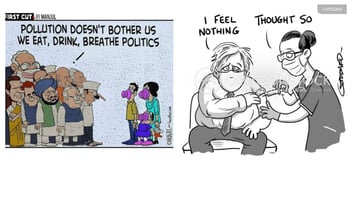What is the state of Air Pollution as NCAP completes 4 years?
Air pollution is a major concern in India, with several cities experiencing high levels of particulate matter and other pollutants. In 2019, the government of India launched the National Clean Air Programme (NCAP) intending to reduce air pollution in the country.
Progress of the NCAP:
The NCAP now aims to reduce the concentration of particulate matter (PM) 2.5 and PM 10 by 40% in 102 cities by 2026. The program also aims to establish a comprehensive monitoring network and strengthen the legal and policy framework for air pollution control. However, despite the program's efforts, pollution levels in many Indian cities have remained high or have even increased in recent years.
Data from the Central Pollution Control Board (CPCB) shows that particulate matter (PM) 2.5 levels have risen in several cities. According to a report by the Energy and Clean Air (ECA), the gap between the targeted and actual reductions of pollutants under the NCAP is substantial. The report also states that the NCAP's targets for reducing pollutants are not ambitious enough.
Achievements of the NCAP:
Despite the challenges, the NCAP has made some achievements in its four years of implementation. One of the major achievements of the program is the establishment of a comprehensive monitoring network for air pollution. The program has also helped to strengthen the legal and policy framework for air pollution control in India.
The NCAP has also helped to increase awareness about air pollution and its impacts on health and the environment. The program has encouraged active participation from citizens, NGOs, and civil society groups in monitoring and reporting air pollution.
Challenges facing the NCAP:
Despite the achievements, the NCAP faces several challenges that are hindering its progress. One of the major challenges is the lack of a robust monitoring system for air pollution. The NCAP's monitoring network is not yet fully operational and is facing several technical and logistical challenges.
Another challenge is the lack of action against polluting industries. The NCAP has failed to take strong action against industries that are major sources of air pollution. This has led to a lack of enforcement of pollution control measures and has hindered the program's progress.
The NCAP also faces a lack of funding and resources. The program's budget is limited, and there is a lack of political will and commitment to adequately fund the program. This has led to a lack of capacity building and training for pollution control officials and staff.
Way Forward:
To overcome the challenges facing the NCAP and achieve its goals, several steps need to be taken. One of the major steps is to establish a robust and comprehensive monitoring system for air pollution. This will require significant investment in technology and capacity building for pollution control officials and staff.
Another step is to take strong action against polluting industries. This will require the strengthening of legal and policy frameworks for pollution control and the enforcement of pollution control measures.
The NCAP also needs to increase its funding and resources. This will require increased political will and commitment to adequately fund the program. This will help to increase capacity building and training for pollution control officials and staff.
Finally, the NCAP needs to increase awareness about air pollution and its impacts on health and the environment. This will require active participation from citizens, NGOs, and civil society groups in monitoring and reporting air pollution.
Conclusion:
In conclusion, the National Clean Air Programme in India has not yet been as successful as intended in reducing air pollution, with pollution levels remaining high or even increasing in many Indian cities. The program faced several challenges, such as a lack of ambitious targets, enforcement of pollution control measures, and funding constraints. To move forward, the NCAP needs to take a more holistic and integrated approach, including setting more ambitious targets, implementing a robust monitoring system, enforcing pollution control measures, and providing adequate funding. Furthermore, the government should also create incentives for industries to adopt cleaner technologies and practices. Only a concerted and sustained effort can reduce pollution levels and improve air quality in India.
Reference:
https://www.thequint.com/climate-change/indias-clean-air-program-completes-4-years-fails-to-keep-pollution-in-control#read-more
https://www.thehindu.com/sci-tech/energy-and-environment/explained-where-do-indian-cities-stand-on-toxic-air/article66378936.ece
https://www.deccanherald.com/national/4-years-into-clean-air-programme-pollution-levels-rising-in-cities-1179812.html
https://energyandcleanair.org/wp/wp-content/uploads/2023/01/Tracing-the-Hazy-Air-2023_-Progress-Report-on-National-Clean-Air-Programme-NCAP_10th-January-2023.pdf

.svg)
.webp?width=1080&height=1080&name=Free%20Case%20Study%20Steel%20Plant%20(1).webp)







Post Comments